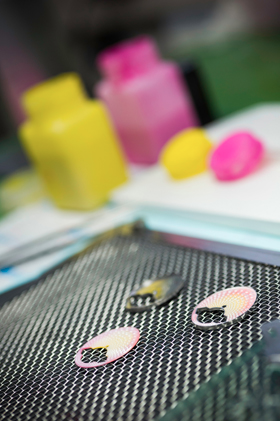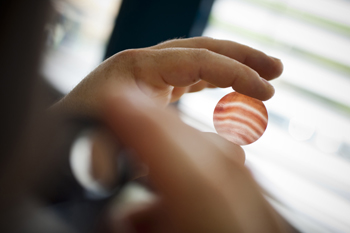Sowind Mother of pearl dial disks being readied for work. Photo by patriceschreyer.com.
Many watches today feature mother-of-pearl dials. These shimmering orbs offer a classic and elegant appeal. However, mother of pearl is brittle and ultra thin when used as a dial, and breakage can easily occur. Here we take a quick look at how these shell dials are made.
To create a mother-of-pearl dials, a host of steps are involved, and depending on how complex the dial design is, they can take a few weeks or a few months to complete. Additionally, there can be as many (and sometimes more) as 15 different artisan steps involved from the start to finish of a mother-of-pearl dial. As such, they are predominantly made by companies that specialize in working with the shell. “Typically, a dial maker with a strong team of approximately two dozen skilled makers can still only produce about 5,000 top-quality mother-of-pearl dials annually.”
Inspecting a disk
The process begins with the actual selection of the shells. Generally, mother of pearl has a milky white luster, however it can be found with a natural pearlescent hue in pale blue, pink, gray and brown. Polishing is an important step, as it brings out the natural luster of the shell. Top-quality shells come in bright white hues and typically hail from Australia and other parts of the Pacific Ocean and exotic seas.
Once the shell colors and variants have been selected — thin sheets measuring 0.2mm in thickness are made. From those sheets, a CNC machine precise cuts the orbs, which are either perfect round shapes or specifically shaped for a watch, such as oval, square, rectangular, etc. These disks will then be used as the watch dial.
Inlaying of mother of pearl and gold for marquetry dials. Photo by patriceschreyer.com.
Because the making of the sheets, and the precise cutting of the orbs can be a costly and time-consuming process, many brands (and dial makers) buy the disks already cut and then start the decorative work from there. From this point on, the disks or orbs are predominantly created by hand. At every stage the dials are carefully checked and inspected for tiny fissures or cracks, which happen easily.
Mother-of-pearl dials can be engraved with patterns ranging from traditional sunray to much more decorative motifs. This work is all delicately done by hand on either the dial front or on the dial back depending on the design.

Some mother-of-pearl dials are painted to achieve their color.For these Girard-Perregaux dials, color is applied to the back. Photo by Patriceschreyer.com.
Dials can be enhanced in color by painting, varnishing or lacquering the back of the mother of pearl. Generally, numerals and markers are then inked onto the dial, or cut-outs are made on the dial for the setting of applied indices. Further embellishments, including the hands and any diamond accents, are added last.
Some brands also start with a thicker dial and then carve away a lot of the mother of pearl in order to offer a sculptural appeal. This is the case with many of the meters d’ arts dials that features nature scenes, birds or animals on them. These dials take much longer to create — often with a single artist spending months to bring them to fruition.








